Optimizing WRF Configurations for Improved Precipitation Forecasting in West Africa: Sensitivity to Cumulus and PBL Schemes in a Senegal Case Study
Abstract
1. Introduction
2. Materials and Methods
2.1. Study Area
2.2. Multi-Source Precipitation and Atmospheric Datasets
2.2.1. Global Forecast System
2.2.2. In Situ Observations
2.2.3. Enhancing National Climate Services
2.2.4. African Rainfall Climatology Version 2
2.2.5. Integrated Multi-Satellite Retrievals for GPM
2.2.6. Climate Hazards Group Infrared Precipitation with Stations
2.2.7. ERA5 Reanalysis and Variables Used
- Total precipitation (TP): Accumulated liquid and frozen water (rain and snow) reaching the surface, combining contributions from large-scale and convective precipitation processes. The accumulation period is typically 1 h for reanalysis data, and values are expressed as water-equivalent depth in meters.
- 2 m temperature (T2m): Air temperature 2 m above the land or water surface, obtained by interpolating between the lowest model level and the surface, expressed in Kelvin (K) and convertible to degrees Celsius (°C).
- Relative humidity (RH): Expressed as a percentage of the saturation water vapor pressure, indicating the degree of saturation of the air. It is calculated over water above 0 °C, over ice below −23 °C, and interpolated between ice and water for temperatures in between.
- Zonal wind component (U): Eastward component of the horizontal wind, where positive values indicate flow toward the east and negative toward the west.
- Meridional wind component (V): Northward component of the horizontal wind, where positive values indicate flow toward the north and negative toward the south.
2.3. Case Studies
2.4. WRF Configurations
2.5. Model Assessment
- BIAS, defined by Equation (1), measures the average difference between model predictions and observations, indicating whether a model systematically overestimates or underestimates values. Although bias is useful for detecting systematic errors, it does not provide information on the magnitude of individual errors, and a low bias may hide large compensating errors [67].where are the predicted values, are the observed values, and n is the number of observations.
- MAE, Equation (2) quantifies the average magnitude of errors in a model’s predictions regardless of their direction. It is easy to interpret and more robust to outliers than RMSE, making it useful for general performance evaluation where large errors are not disproportionately penalized. MAE provides a straightforward measure of accuracy in the same units as the observed variable [68].
- RMSE, Equation (3) calculates the square root of the average squared differences between predictions and observations. It is sensitive to large errors due to the squaring, making it particularly useful when large deviations are critical to assess. However, its sensitivity to outliers may exaggerate overall error metrics in noisy data [69].
- Correlation coefficient (r), Equation (4) assesses the strength and direction of the linear relationship between predicted and observed values. A value close to +1 indicates a strong positive linear relationship, while 0 suggests no correlation. While correlation is useful for pattern detection, it does not account for biases or differences in magnitude between datasets [70].
- The Taylor diagram, introduced by [71], is a visual tool that offers a statistical overview of the similarity between patterns. Consider factors such as correlation (r), normalized standard deviation (), and normalized RMSE between points. It serves as a graphical summary to assess how well a set of patterns aligns with observations, making it particularly valuable for evaluating various aspects of complex models or comparing the skills of different models.
2.6. Selection of Reference Dataset and Validation of WRF Simulations
3. Results
3.1. Evaluation of Rainfall Products and WRF Simulations
3.1.1. Analysis of Simulations: 5 September 2020 vs. 3 September 2021 Rainfall Events
3.1.2. Evaluation of WRF Model Performance on Diurnal Cycles
3.1.3. Evaluation of WRF-Simulated Atmospheric Dynamics Across Multiple Vertical Levels
4. Discussion
5. Conclusions
Author Contributions
Funding
Institutional Review Board Statement
Informed Consent Statement
Data Availability Statement
Acknowledgments
Conflicts of Interest
Appendix A
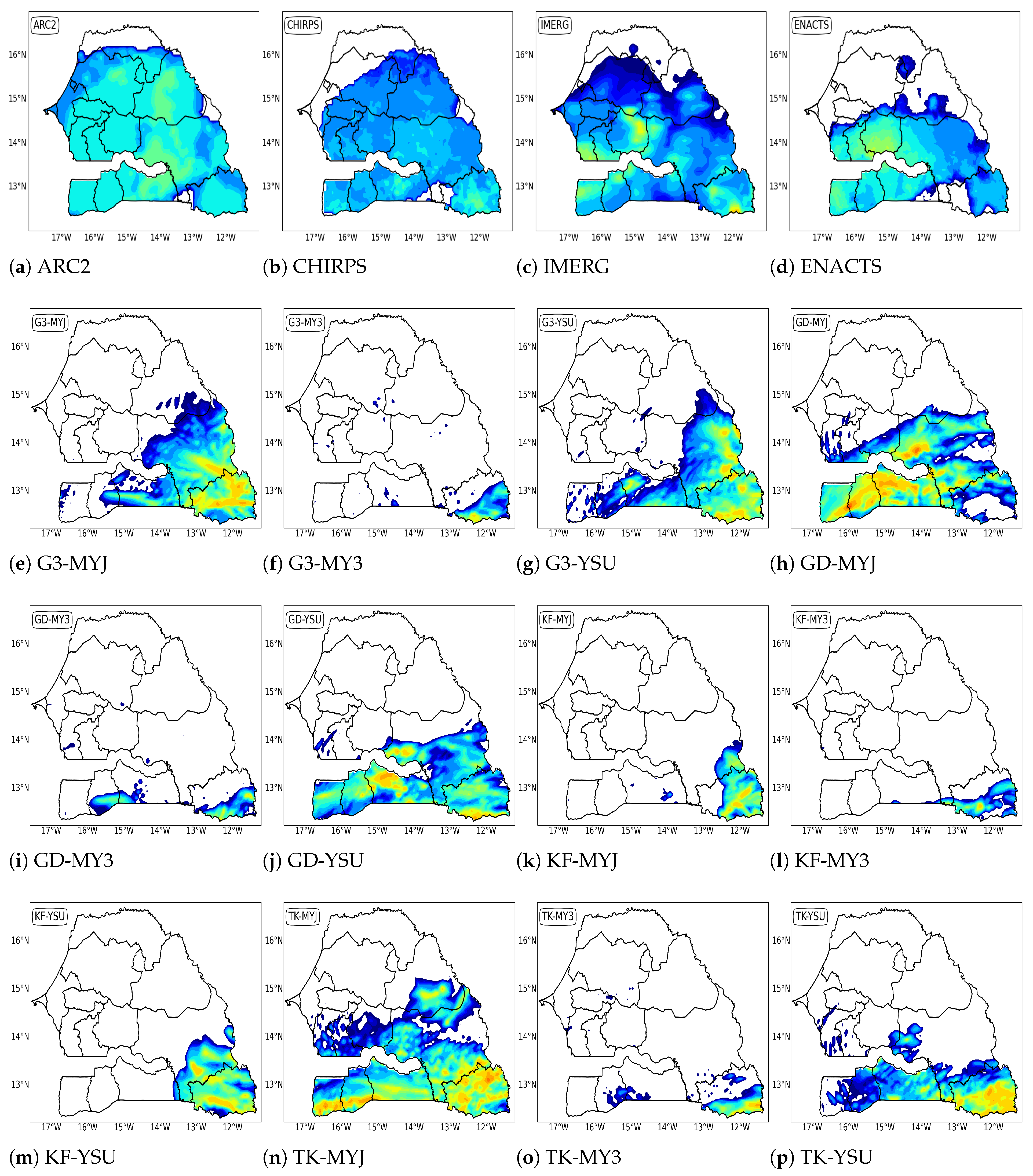
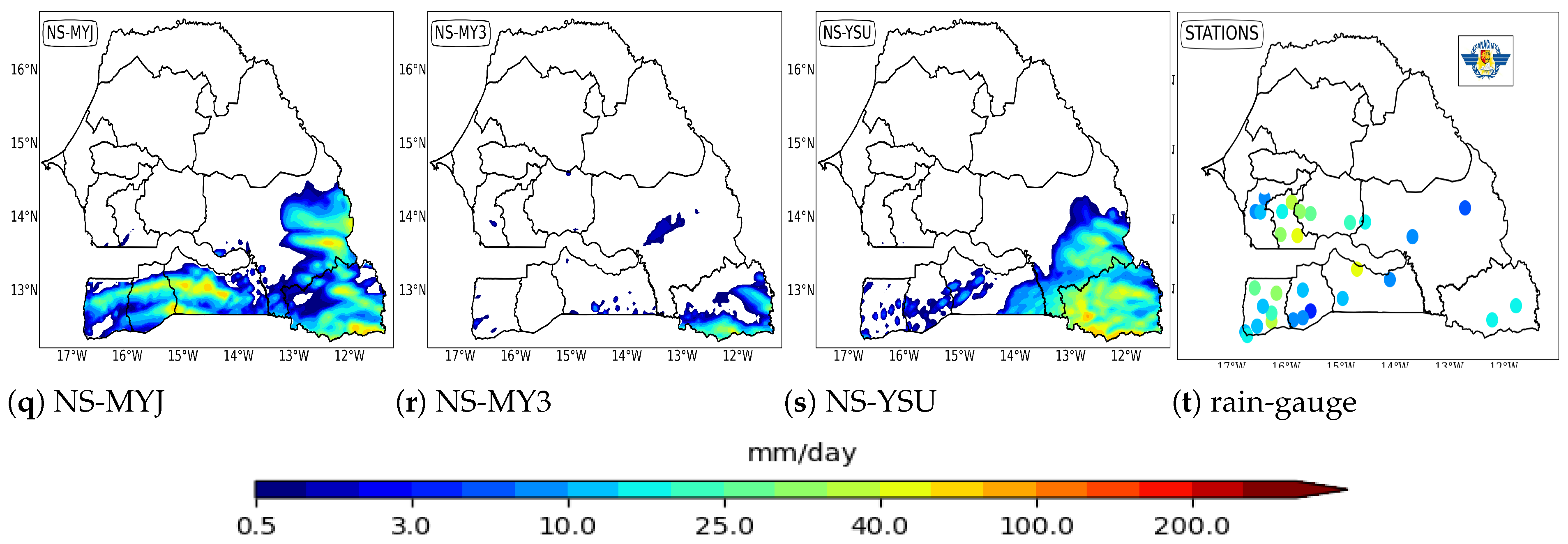

References
- Sarr, M.A.; Zoromé, M.; Seidou, O.; Bryant, C.R.; Gachon, P. Recent trends in selected extreme precipitation indices in Senegal—A changepoint approach. J. Hydrol. 2013, 505, 326–334. [Google Scholar] [CrossRef]
- Barry, A.A.; Caesar, J.; Klein Tank, A.M.G.; Aguilar, E.; McSweeney, C.; Cyrille, A.M.; Nikiema, M.P.; Narcisse, K.B.; Sima, F.; Stafford, G.; et al. West Africa climate extremes and climate change indices. Int. J. Climatol. 2018, 38, e921–e938. [Google Scholar] [CrossRef]
- Diouf, S.; Sambou, M.-J.G.; Deme, A.; Fall, P.; Gueye, D.; Mignot, J.; Janicot, S. Dust Content Modulation and Spring Heat Waves in Senegal (2003–2022). Atmosphere 2024, 15, 1413. [Google Scholar] [CrossRef]
- Hastenrath, S.; Lamb, P.J. Climatic Atlas of the Tropical Atlantic and Eastern Pacific Oceans; University of Wisconsin: Madison, WI, USA, 1977. [Google Scholar]
- Xie, S.-P.; Carton, J.A. Tropical Atlantic Variability: Patterns, Mechanisms, and Impacts. In Earth’s Climate: The Ocean–Atmosphere Interaction; Geophysical Monograph Series; American Geophysical Union: Washington, DC, USA, 2004; Volume 147, pp. 121–142. [Google Scholar]
- Lavaysse, C.; Flamant, C.; Janicot, S.; Parker, D.J.; Lafore, J.-P.; Sultan, B.; Pelon, J. Seasonal Evolution of the West African Heat Low: A Climatological Perspective. Climate Dyn. 2009, 33, 313–330. [Google Scholar] [CrossRef]
- Issa Lélé, M.; Lamb, P.J. Variability of the Intertropical Front (ITF) and Rainfall over the West African Sudan–Sahel Zone. J. Climate 2010, 23, 3984–4004. [Google Scholar] [CrossRef]
- Burpee, R.W. The Origin and Structure of Easterly Waves in the Lower Troposphere of North Africa. J. Atmos. Sci. 1972, 29, 77–90. [Google Scholar] [CrossRef]
- Cook, K.H. Generation of the African Easterly Jet and Its Role in Determining West African Precipitation. J. Climate 1999, 12, 1165–1184. [Google Scholar] [CrossRef]
- Diedhiou, A.; Janicot, S.; Viltard, A.; De Felice, P.; Laurent, H. Easterly Wave Regimes and Associated Convection over West Africa and Tropical Atlantic: Results from the NCEP/NCAR and ECMWF Reanalyses. Climate Dyn. 1999, 15, 795–822. [Google Scholar] [CrossRef]
- Meukaleuni, C.; Lenouo, A.; Monkam, D. Climatology of Convective Available Potential Energy (CAPE) in ERA-Interim Reanalysis over West Africa. Atmos. Sci. Lett. 2016, 17, 65–70. [Google Scholar] [CrossRef]
- Olaniyan, E.; Afiesimama, E.; Oni, F.; Lawal, K.A. Simulating the Daily Evolution of West African Monsoon Using High Resolution Regional COSMO-Model: A Case Study of the First Half of 2015 over Nigeria. J. Climatol. Weather Forecast. 2015, 3, 142. [Google Scholar] [CrossRef]
- Mathon, V.; Laurent, H.; Lebel, T. Mesoscale Convective System Rainfall in the Sahel. J. Appl. Meteorol. Climatol. 2002, 41, 1081–1092. [Google Scholar] [CrossRef]
- Milovac, J.; Warrach-Sagi, K.; Behrendt, A.; Späth, F.; Ingwersen, J.; Wulfmeyer, V. Investigation of PBL Schemes Combining the WRF Model Simulations with Scanning Water Vapor Differential Absorption Lidar Measurements. J. Geophys. Res. Atmos. 2016, 121, 624–649. [Google Scholar] [CrossRef]
- Hong, S.-Y.; Dudhia, J. Next-Generation Numerical Weather Prediction: Bridging Parameterization, Explicit Clouds, and Large Eddies. Bull. Am. Meteorol. Soc. 2012, 93, ES6–ES9. [Google Scholar] [CrossRef]
- Prein, A.F.; Langhans, W.; Fosser, G.; Ferrone, A.; Ban, N.; Goergen, K.; Keller, M.; Tölle, M.; Gutjahr, O.; Feser, F.; et al. A Review on Regional Convection-Permitting Climate Modeling: Demonstrations, Prospects, and Challenges. Rev. Geophys. 2015, 53, 323–361. [Google Scholar] [CrossRef] [PubMed]
- Klemp, J.B. Advances in the WRF Model for Convection-Resolving Forecasting. Adv. Geosci. 2006, 7, 25–29. [Google Scholar] [CrossRef]
- Solano-Farias, F.; Ojeda, M.G.-V.; Donaire-Montaño, D.; Rosa-Cánovas, J.J.; Castro-Díez, Y.; Esteban-Parra, M.J.; Gámiz-Fortis, S.R. Assessment of Physical Schemes for WRF Model in Convection-Permitting Mode over Southern Iberian Peninsula. Atmos. Res. 2024, 299, 107175. [Google Scholar] [CrossRef]
- Deng, A.; Stauffer, D.R. On Improving 4-km Mesoscale Model Simulations. J. Appl. Meteorol. Climatol. 2006, 45, 361–381. [Google Scholar] [CrossRef]
- Skamarock, W.C.; Klemp, J.B.; Dudhia, J.; Gill, D.O.; Liu, Z.; Berner, J.; Huang, X.Y. A Description of the Advanced Research WRF Model Version 4.3 (No. NCAR/TN-556+ STR); National Center for Atmospheric Research: Boulder, CO, USA, 2021. [Google Scholar]
- Powers, J.G.; Klemp, J.B.; Skamarock, W.C.; Davis, C.A.; Dudhia, J.; Gill, D.O.; Coen, J.L.; Gochis, D.J.; Ahmadov, R.; Peckham, S.E.; et al. The Weather Research and Forecasting Model: Overview, System Efforts, and Future Directions. Bull. Am. Meteorol. Soc. 2017, 98, 1717–1737. [Google Scholar] [CrossRef]
- Crétat, J.; Pohl, B.; Richard, Y.; Drobinski, P. Sensibilité d’un Modèle à Aire Limitée à sa Paramétrisation Physique: Application en Afrique Australe. In Proceedings of the Ateliers de Modélisation de l’Atmosphère, Toulouse, France, 26–28 January 2010. [Google Scholar]
- Flaounas, E.; Bastin, S.; Janicot, S. Regional climate modelling of the 2006 West African monsoon: Sensitivity to convection and planetary boundary layer parameterisation using WRF. Clim. Dyn. 2011, 36, 1083–1105. [Google Scholar] [CrossRef]
- Noble, E.; Druyan, L.M.; Fulakeza, M. The Sensitivity of WRF Daily Summertime Simulations over West Africa to Alternative Parameterizations. Part II: Precipitation. Mon. Weather Rev. 2017, 145, 215–233. [Google Scholar] [CrossRef]
- Igri, P.M.; Tanessong, R.S.; Vondou, D.A.; Panda, J.; Garba, A.; Mkankam, F.K.; Kamga, A. Assessing the Performance of WRF Model in Predicting High-Impact Weather Conditions over Central and Western Africa: An Ensemble-Based Approach. Nat. Hazards 2018, 93, 1565–1587. [Google Scholar] [CrossRef]
- Bouali, L. Prévisibilité des Précipitations Ouest Africaines (Échelles Intrasaisonnières et Saisonnières) au Travers des Simulations Type DEMETER et des Observations. Ph.D. Thesis, Université de Bourgogne, Dijon, France, 2009. [Google Scholar]
- Bodian, A.; Dezetter, A.; Dacosta, H. Apport de la modélisation pluie-débit pour la connaissance de la ressource en eau: Application au haut bassin du fleuve Sénégal. Climatologie 2012, 9, 109–125. [Google Scholar] [CrossRef]
- Dione, O. Évolution climatique récente et dynamique fluviale dans les hauts bassins des fleuves Sénégal et Gambie. Sci. Chang. Planét/Sécheresse 1998, 8, 300–301. [Google Scholar]
- Sane, Y.; Panthou, G.; Bodian, A.; Vischel, T.; Lebel, T.; Dacosta, H.; Quantin, G.; Wilcox, C.; Ndiaye, O.; Diongue-Niang, A.; et al. Intensity–duration–frequency (IDF) rainfall curves in Senegal. Nat. Hazards Earth Syst. Sci. 2018, 18, 1849–1866. [Google Scholar] [CrossRef]
- Diop, L.; Bodian, A.; Diallo, D. Spatiotemporal Trend Analysis of the Mean Annual Rainfall in Senegal. Eur. Sci. J. 2016, 12, 231. [Google Scholar] [CrossRef]
- Salack, S.; Muller, B.; Gaye, A.T. Rain-Based Factors of High Agricultural Impacts over Senegal. Part I: Integration of Local to Sub-Regional Trends and Variability. Theor. Appl. Climatol. 2011, 106, 1–22. [Google Scholar] [CrossRef]
- Sagna, P.; Ndiaye, O.; Diop, C.; Niang, A.D.; Sambou, P.C. Les variations récentes du climat constatées au Sénégal sont-elles en phase avec les descriptions données par les scénarios du GIEC? Pollut. Atmos. Clim. Santé Soc. 2016, 227. [Google Scholar] [CrossRef]
- Wang, J.-W.A.; Sardeshmukh, P.D.; Compo, G.P.; Whitaker, J.S.; Slivinski, L.C.; McColl, C.M.; Pegion, P.J. Sensitivities of the NCEP Global Forecast System. Mon. Weather Rev. 2019, 147, 1237–1256. [Google Scholar] [CrossRef]
- Faniriantsoa, R.; Hansen, J. Enhancing ANACIM High-Resolution Merged Historical Datasets by Generating Additional Meteorological Parameters. In Accelerating Impacts of CGIAR Climate Research for Africa; World Bank: Washington, DC, USA, 2022. [Google Scholar]
- Maidment, R.I.; Grimes, D.; Black, E.; Tarnavsky, E.; Young, M.; Greatrex, H.; Allan, R.P.; Stein, T.; Nkonde, E.; Senkunda, S.; et al. A new, long-term daily satellite-based rainfall dataset for operational monitoring in Africa. Sci. Data 2017, 4, 170063. [Google Scholar] [CrossRef]
- Novella, N.S.; Thiaw, W.M. African Rainfall Climatology Version 2 for Famine Early Warning Systems. J. Appl. Meteorol. Climatol. 2013, 52, 588–606. [Google Scholar] [CrossRef]
- Tan, J.; Huffman, G.J.; Bolvin, D.T.; Nelkin, E.J. Diurnal cycle of IMERG V06 precipitation. Geophys. Res. Lett. 2019, 46, 13584–13592. [Google Scholar] [CrossRef]
- Funk, C.C.; Peterson, P.J.; Landsfeld, M.F.; Pedreros, D.H.; Verdin, J.P.; Rowland, J.D.; Romero, B.E.; Husak, G.J.; Michaelsen, J.C.; Verdin, A.P. A Quasi-Global Precipitation Time Series for Drought Monitoring; US Geological Survey: Reston, VA, USA, 2014.
- Hersbach, H.; Bell, B.; Berrisford, P.; Hirahara, S.; Horányi, A.; Muñoz-Sabater, J.; Nicolas, J.; Peubey, C.; Radu, R.; Schepers, D.; et al. The ERA5 global reanalysis. Q. J. R. Meteorol. Soc. 2020, 146, 1999–2049. [Google Scholar] [CrossRef]
- Diedhiou, S.; Rauch, M.; Dieng, A.L.; Bliefernicht, J.; Sy, S.; Sall, S.M.; Kunstmann, H. Extreme Rainfall in Dakar (Senegal): A Case Study for 5 September 2020. Front. Water 2024, 6, 1439404. [Google Scholar] [CrossRef]
- ANACIM. Bulletin Pluviométrique et Hydrologique Juillet-Août-Septembre 2020. Agence Nationale de l’Aviation Civile et de la Météorologie du Sénégal, 2020. Available online: https://www.secnsa.sn/wp-content/uploads/2022/09/202011-Bulletin-SAP-Juillet-Aout-Septembre-2020_recu-par-email-du-26-octobre-2020-c.pdf (accessed on 2 July 2025).
- Reuters. Senegal Activates Emergency Floods Aid Plan After Downpour; Reuters: London, UK, 2020. [Google Scholar]
- Ndiaye, A.L. Impacts des Inondations de 2020 au Niveau des Ménages Sinistrés—Enquête de Base pour l’Évaluation des Besoins Post Catastrophes; United Nations Development Programme: New York, NY, USA, 2021. [Google Scholar]
- Liu, Y.; Zhuo, L.; Han, D. Developing spin-up time framework for WRF extreme precipitation simulations. J. Hydrol. 2023, 620, 129443. [Google Scholar] [CrossRef]
- Skamarock, W.C. Evaluating mesoscale NWP models using kinetic energy spectra. Mon. Weather Rev. 2004, 132, 3019–3032. [Google Scholar] [CrossRef]
- Nooni, I.K.; Tan, G.; Hongming, Y.; Chaibou, A.A.S.; Habtemicheal, B.A.; Gnitou, G.T.; Lim Kam Sian, K.T.C. Assessing the performance of WRF model in simulating heavy precipitation events over East Africa using satellite-based precipitation product. Remote Sens. 2022, 14, 1964. [Google Scholar] [CrossRef]
- Grell, G.A. Prognostic Evaluation of Assumptions Used by Cumulus Parameterizations. Mon. Weather Rev. 1993, 121, 764–787. [Google Scholar] [CrossRef]
- Grell, G.A.; Dévényi, D. A Generalized Approach to Parameterizing Convection Combining Ensemble and Data Assimilation Techniques. Geophys. Res. Lett. 2002, 29, 38–41. [Google Scholar] [CrossRef]
- Kain, J.S. The Kain–Fritsch Convective Parameterization: An Update. J. Appl. Meteorol. Climatol. 2004, 43, 170–181. [Google Scholar] [CrossRef]
- Han, J.; Pan, H.-L. Revision of Convection and Vertical Diffusion Schemes in the NCEP Global Forecast System. Weather Forecast. 2011, 26, 520–533. [Google Scholar] [CrossRef]
- Tiedtke, M. A Comprehensive Mass Flux Scheme for Cumulus Parameterization in Large-Scale Models. Mon. Weather Rev. 1989, 117, 1779–1800. [Google Scholar] [CrossRef]
- Zhang, C.; Wang, Y.; Hamilton, K. Improved Representation of Boundary Layer Clouds over the Southeast Pacific in ARW-WRF Using a Modified Tiedtke Cumulus Parameterization Scheme. Mon. Weather Rev. 2011, 139, 3489–3513. [Google Scholar] [CrossRef]
- Thompson, G.; Field, P.R.; Rasmussen, R.M.; Hall, W.D. Explicit Forecasts of Winter Precipitation Using an Improved Bulk Microphysics Scheme. Part II: Implementation of a New Snow Parameterization. Mon. Weather Rev. 2008, 136, 5095–5115. [Google Scholar] [CrossRef]
- Iacono, M.J.; Delamere, J.S.; Mlawer, E.J.; Shephard, M.W.; Clough, S.A.; Collins, W.D. Radiative Forcing by Long-Lived Greenhouse Gases: Calculations with the AER Radiative Transfer Models. J. Geophys. Res. Atmos. 2008, 113, D13103. [Google Scholar] [CrossRef]
- Janjić, Z.I. The Step-Mountain Eta Coordinate Model: Further Developments of the Convection, Viscous Sublayer, and Turbulence Closure Schemes. Mon. Weather Rev. 1994, 122, 927–945. [Google Scholar] [CrossRef]
- Nakanishi, M.; Niino, H. Development of an Improved Turbulence Closure Model for the Atmospheric Boundary Layer. J. Meteorol. Soc. Jpn. Ser. II 2009, 87, 895–912. [Google Scholar] [CrossRef]
- Hong, S.-Y.; Noh, Y.; Dudhia, J. A New Vertical Diffusion Package with an Explicit Treatment of Entrainment Processes. Mon. Weather Rev. 2006, 134, 2318–2341. [Google Scholar] [CrossRef]
- Tewari, M.; Chen, F.; Wang, W.; Dudhia, J.; LeMone, M.; Mitchell, K.; Ek, M.; Gayno, G.; Wegiel, J.; Mukul Tewari, N. Implementation and Verification of the Unified NOAH Land Surface Model in the WRF Model. In Proceedings of the 20th Conference on Weather Analysis and Forecasting/16th Conference on Numerical Weather Prediction, Seattle, WA, USA, 12–16 January 2004; Volume 14. [Google Scholar]
- Klein, C.; Heinzeller, D.; Bliefernicht, J.; Kunstmann, H. Variability of West African Monsoon Patterns Generated by a WRF Multi-Physics Ensemble. Clim. Dyn. 2015, 45, 2733–2755. [Google Scholar] [CrossRef]
- Chawla, I.; Osuri, K.K.; Mujumdar, P.P.; Niyogi, D. Assessment of the Weather Research and Forecasting (WRF) model for simulation of extreme rainfall events in the upper Ganga Basin. Hydrol. Earth Syst. Sci. 2018, 22, 1095–1117. [Google Scholar] [CrossRef]
- Douluri, D.L.; Chakraborty, A. Assessment of WRF-ARW model parameterization schemes for extreme heavy precipitation events associated with atmospheric rivers over West Coast of India. Atmos. Res. 2021, 249, 105330. [Google Scholar] [CrossRef]
- Merino, A.; García-Ortega, E.; Navarro, A.; Sánchez, J.L.; Tapiador, F.J. WRF hourly evaluation for extreme precipitation events. Atmos. Res. 2022, 274, 106215. [Google Scholar] [CrossRef]
- Gbode, I.E.; Dudhia, J.; Ogunjobi, K.O.; Ajayi, V.O. Sensitivity of different physics schemes in the WRF model during a West African monsoon regime. Theor. Appl. Climatol. 2019, 136, 733–751. [Google Scholar] [CrossRef]
- Drigeard, E. Microphysique Glacée des Systèmes Convectifs Observés dans le Cadre de Megha-Tropiques en Afrique de l’Ouest: Comparaison des Mesures Aéroportées avec des Radars Sol et un Modèle Numérique. Ph.D. Thesis, Université Blaise Pascal-Clermont-Ferrand II, Aubière, France, 2014. [Google Scholar]
- Mohamed, A.; Faye, C.; Othman, A.; Abdelrady, A. Hydro-Geophysical Evaluation of the Regional Variability of Senegal’s Terrestrial Water Storage Using Time-Variable Gravity Data. Remote Sens. 2022, 14, 4059. [Google Scholar] [CrossRef]
- Nakalembe, C.; Frimpong, D.B.; Kerner, H.; Sarr, M.A. A 40-Year Remote Sensing Analysis of Spatiotemporal Temperature and Rainfall Patterns in Senegal. Front. Clim. 2025, 7, 1462626. [Google Scholar] [CrossRef]
- Willmott, C.J. Some Comments on the Evaluation of Model Performance. Bull. Am. Meteorol. Soc. 1982, 63, 1309–1313. [Google Scholar] [CrossRef]
- Willmott, C.J.; Matsuura, K. Advantages of the Mean Absolute Error (MAE) over the Root Mean Square Error (RMSE) in Assessing Average Model Performance. Clim. Res. 2005, 30, 79–82. [Google Scholar] [CrossRef]
- Chai, T.; Draxler, R.R. Root mean square error (RMSE) or mean absolute error (MAE)?—Arguments against avoiding RMSE in the literature. Geosci. Model Dev. 2014, 7, 1247–1250. [Google Scholar] [CrossRef]
- Wilks, D.S. Statistical Methods in the Atmospheric Sciences; Academic Press: San Diego, CA, USA, 2011; Volume 100. [Google Scholar]
- Taylor, K.E. Summarizing multiple aspects of model performance in a single diagram. J. Geophys. Res. Atmos. 2001, 106, 7183–7192. [Google Scholar] [CrossRef]
- Young, M.P.; Williams, C.J.R.; Chiu, J.C.; Maidment, R.I.; Chen, S.-H. Investigation of discrepancies in satellite rainfall estimates over Ethiopia. J. Hydrometeorol. 2014, 15, 2347–2369. [Google Scholar] [CrossRef]
- Ahmed, R.H.; Roomi, T.O.; Hussain, H.H.; Salah, Z. Sensitivity of Different Physical Schemes in WRF Model of a Rainfall Event in Baghdad Station. Al-Mustansiriyah J. Sci. 2023, 34, 1–7. [Google Scholar] [CrossRef]
- Gbode, I.E.; Babalola, T.E.; Diro, G.T.; Olaniyan, E.O.; Dosio, A.; Lennard, C.; Adefisan, E.A. Assessment of ERA5 and ERA-Interim in reproducing mean and extreme climates over West Africa. Adv. Atmos. Sci. 2023, 40, 570–586. [Google Scholar] [CrossRef]
- Quagraine, K.A.; Nkrumah, F.; Klein, C.; Klutse, N.A.B.; Quagraine, K.T. West African Summer Monsoon precipitation variability as represented by reanalysis datasets. Climate 2020, 8, 111. [Google Scholar] [CrossRef]
- Bodjrenou, R.; Cohard, J.-M.; Hector, B.; Lawin, E.A.; Chagnaud, G.; Danso, D.K.; N’tcha, M.Y.; Badou, F.; Ahamide, B. Evaluation of reanalysis estimates of precipitation, radiation, and temperature over Benin (West Africa). J. Appl. Meteorol. Climatol. 2023, 62, 1005–1022. [Google Scholar] [CrossRef]
- Lavers, D.A.; Simmons, A.; Vamborg, F.; Rodwell, M.J. An evaluation of ERA5 precipitation for climate monitoring. Q. J. R. Meteorol. Soc. 2022, 148, 3152–3165. [Google Scholar] [CrossRef]
- Pohl, B.; Crétat, J.; Camberlin, P. Testing WRF capability in simulating the atmospheric water cycle over Equatorial East Africa. Clim. Dyn. 2011, 37, 1357–1379. [Google Scholar] [CrossRef]
- Crétat, J.; Richard, Y.; Pohl, B.; Rouault, M.; Reason, C.; Fauchereau, N. Recurrent daily rainfall patterns over South Africa and associated dynamics during the core of the austral summer. Int. J. Climatol. 2012, 32, 261–273. [Google Scholar] [CrossRef]
- Berry, G.J.; Thorncroft, C.D. African easterly wave dynamics in a mesoscale numerical model: The upscale role of convection. J. Atmos. Sci. 2012, 69, 1267–1283. [Google Scholar] [CrossRef]
- Vemuri, A.; Buckingham, S.; Munters, W.; Helsen, J.; Van Beeck, J. Sensitivity analysis of mesoscale simulations to physics parameterizations over the Belgian North Sea using Weather Research and Forecasting–Advanced Research WRF (WRF-ARW). Wind Energy Sci. 2022, 7, 1869–1888. [Google Scholar] [CrossRef]
- Karki, R.; ul Hasson, S.; Gerlitz, L.; Talchabhadel, R.; Schenk, E.; Schickhoff, U.; Scholten, T.; Böhner, J. WRF-based simulation of an extreme precipitation event over the Central Himalayas: Atmospheric mechanisms and their representation by microphysics parameterization schemes. Atmos. Res. 2018, 214, 21–35. [Google Scholar] [CrossRef]
- Ruijsch, J.; Taylor, C.M.; Hutjes, R.W.A.; Teuling, A.J. Scale-dependent cloud enhancement from land restoration in West African drylands. Commun. Earth Environ. 2025, 6, 174. [Google Scholar] [CrossRef]
- Wu, M.; Nikulin, G.; Kjellström, E.; Belušić, D.; Jones, C.; Lindstedt, D. The impact of regional climate model formulation and resolution on simulated precipitation in Africa. Earth Syst. Dyn. 2020, 11, 377–394. [Google Scholar] [CrossRef]
- Mwanthi, A.M.; Mutemi, J.N.; Opijah, F.J.; Mutua, F.M.; Atheru, Z.; Artan, G. Implications of WRF model resolutions on resolving rainfall variability with topography over East Africa. Front. Clim. 2024, 6, 1311088. [Google Scholar] [CrossRef]

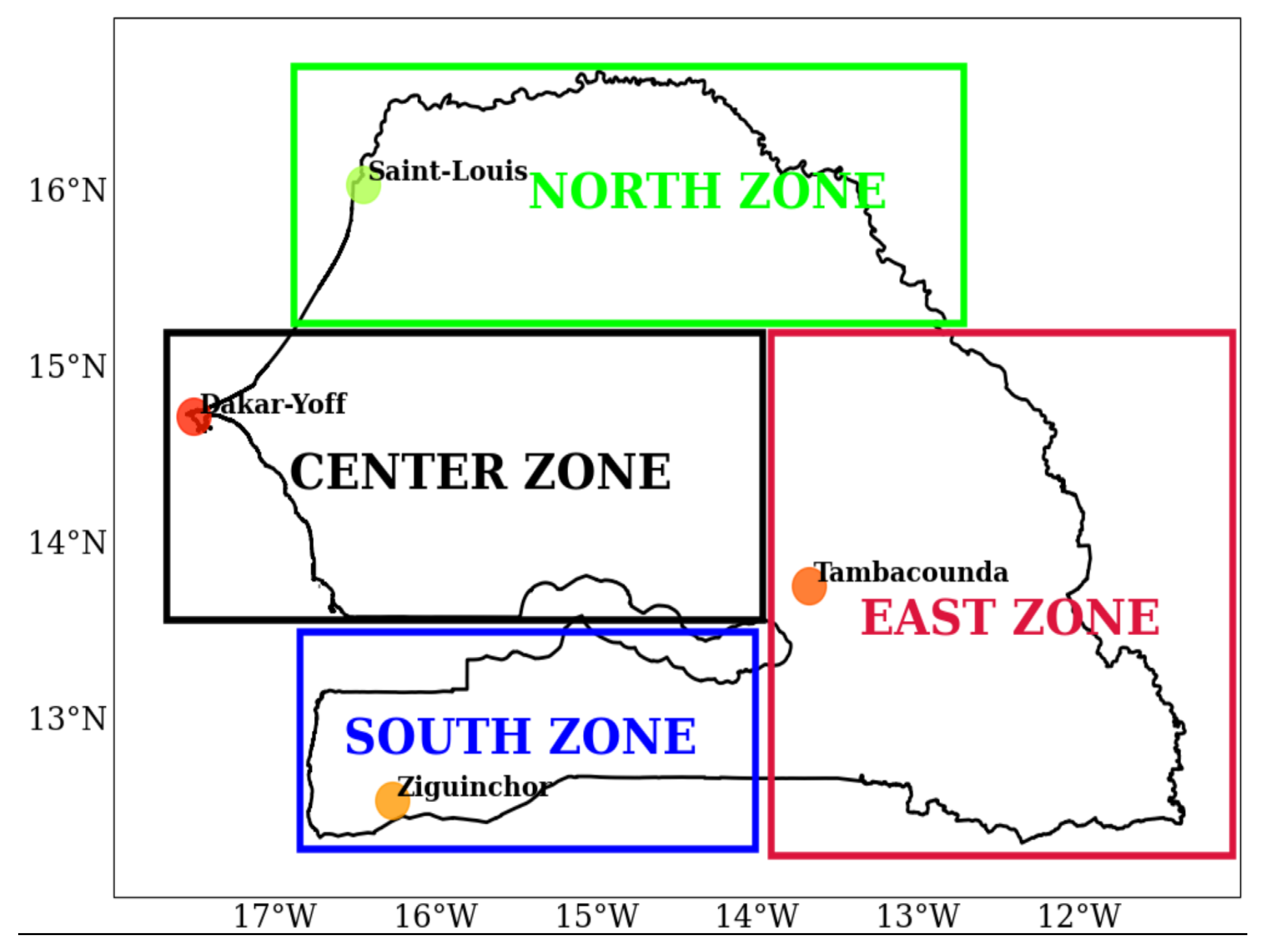


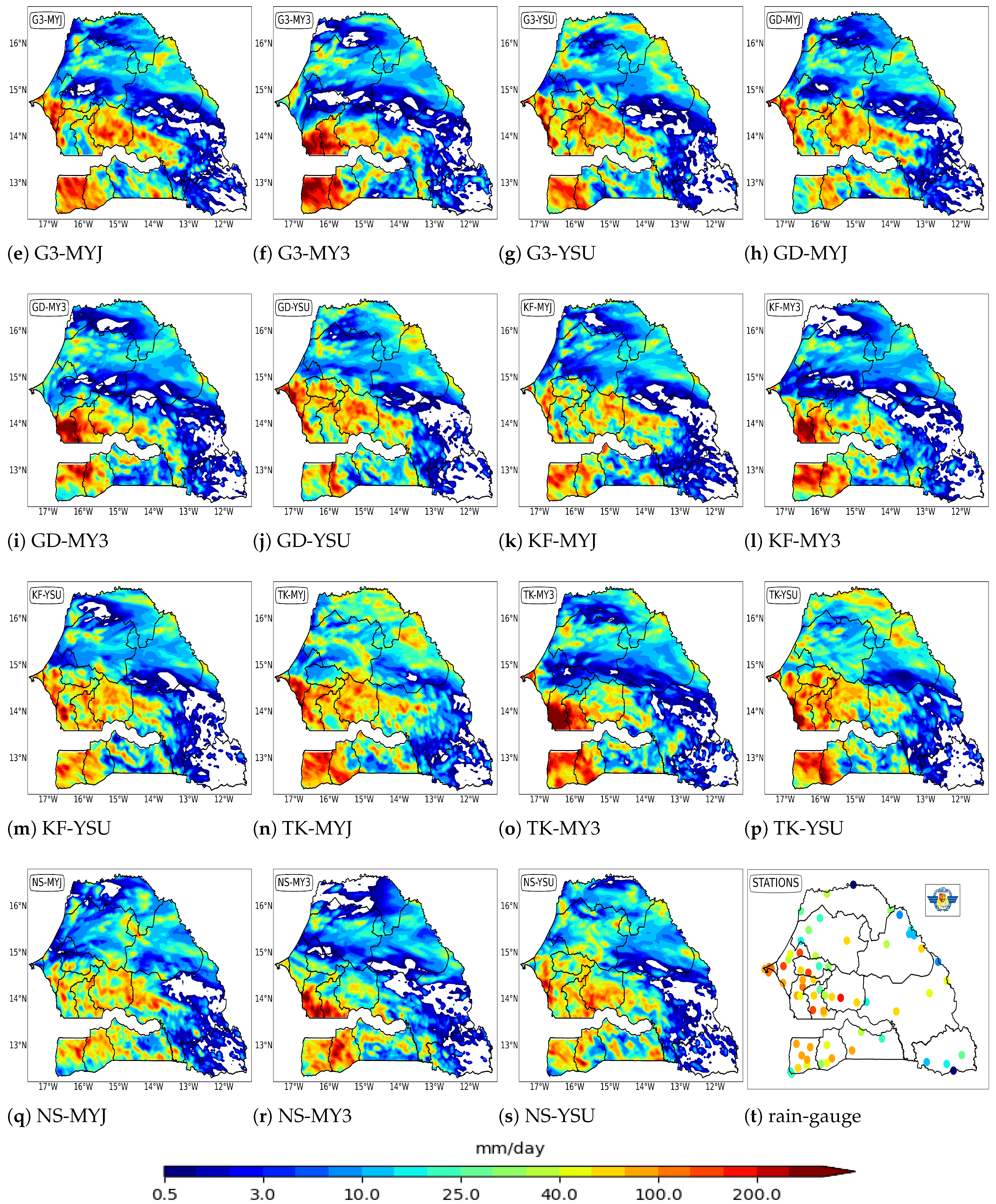

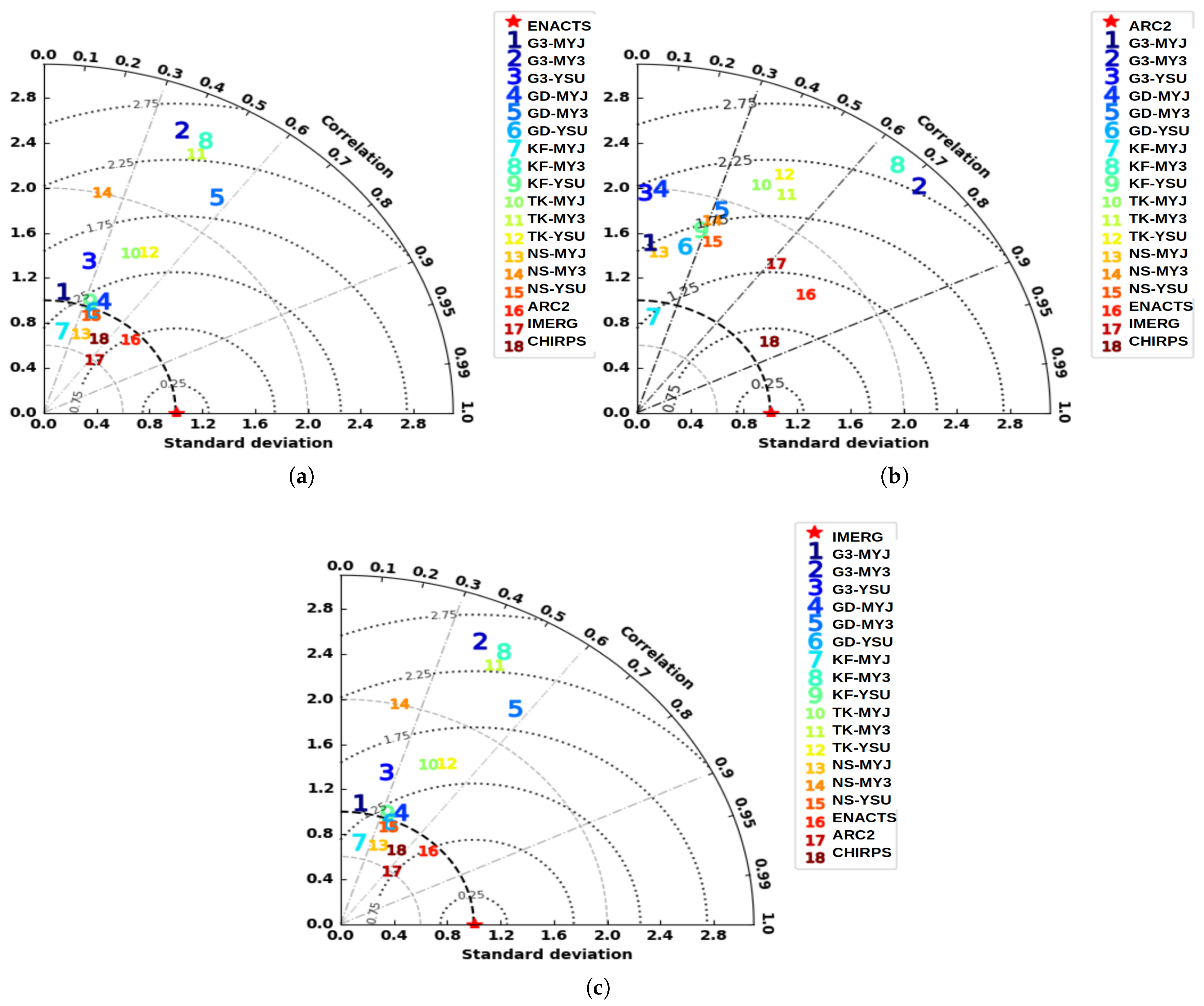

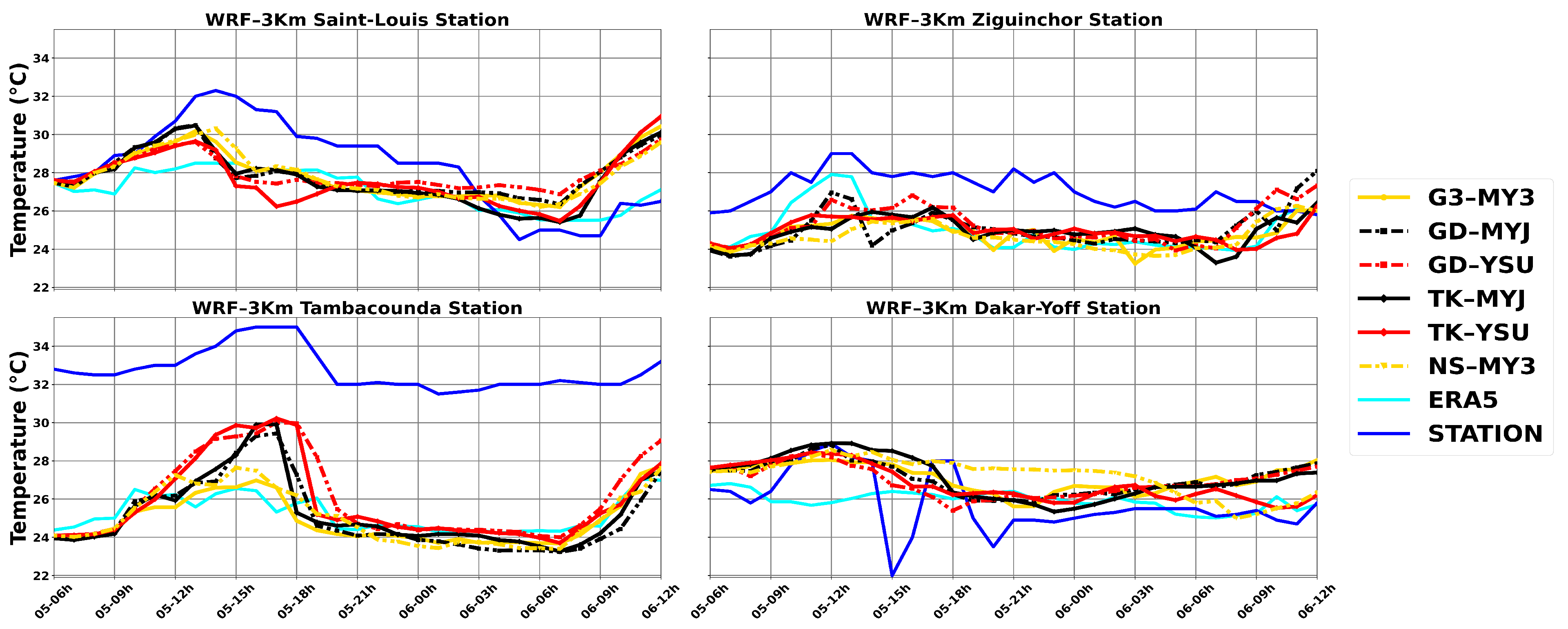


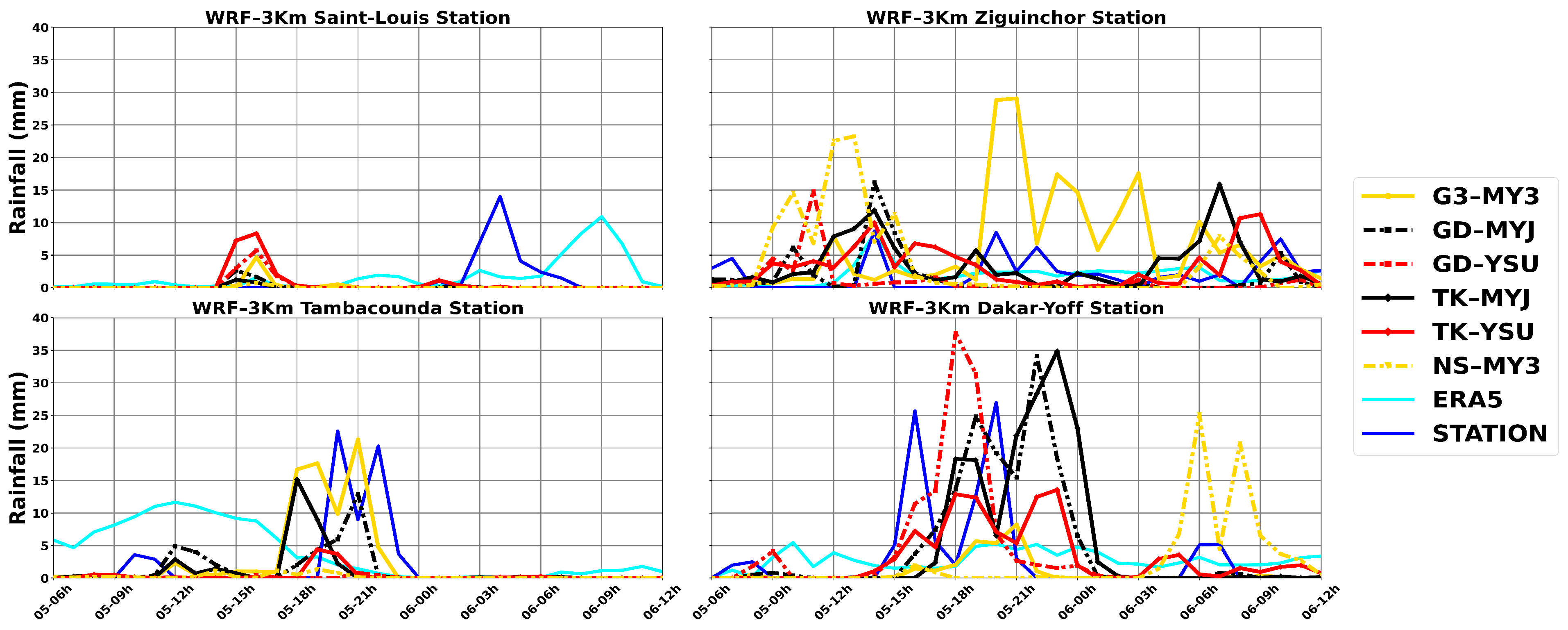
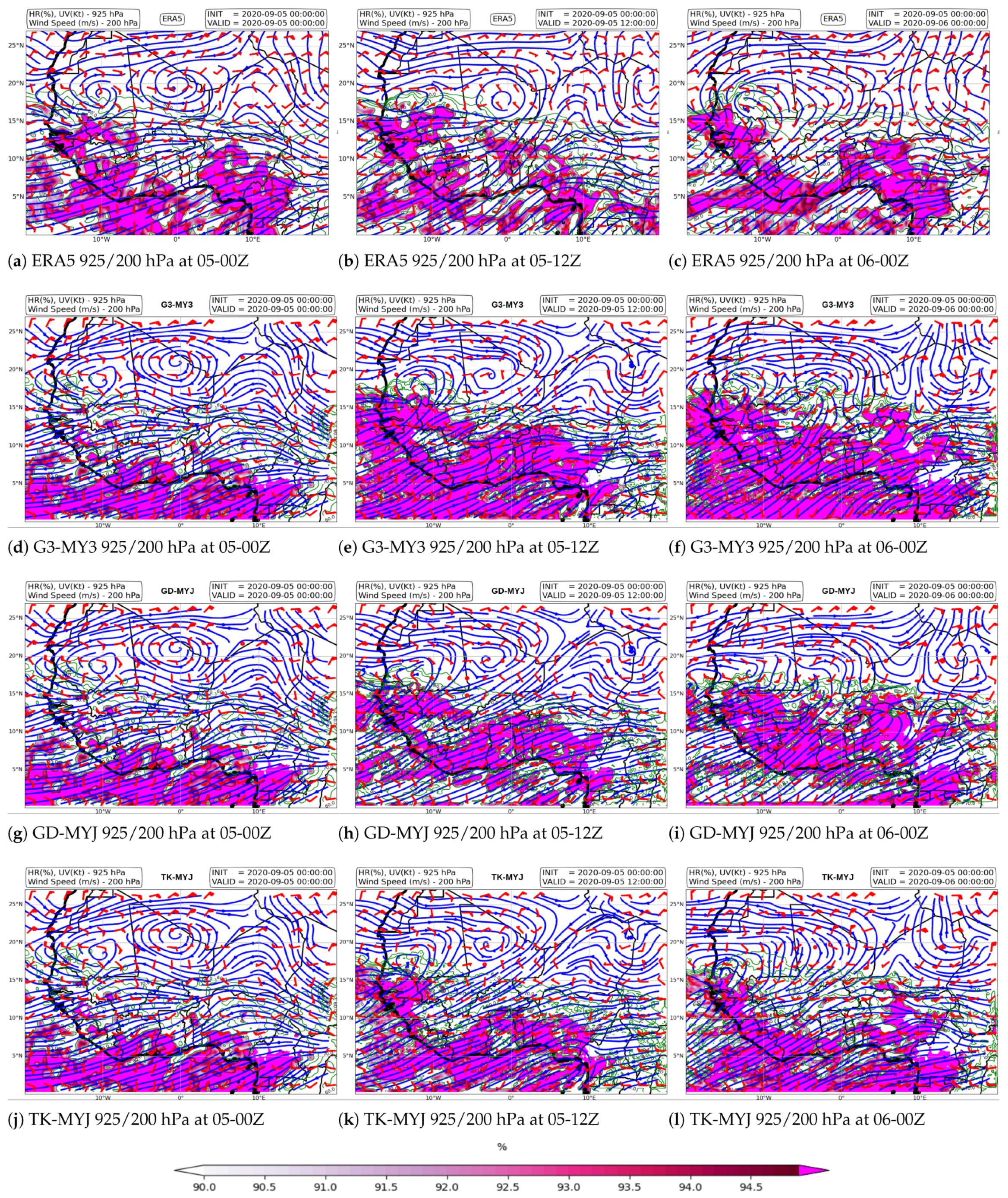
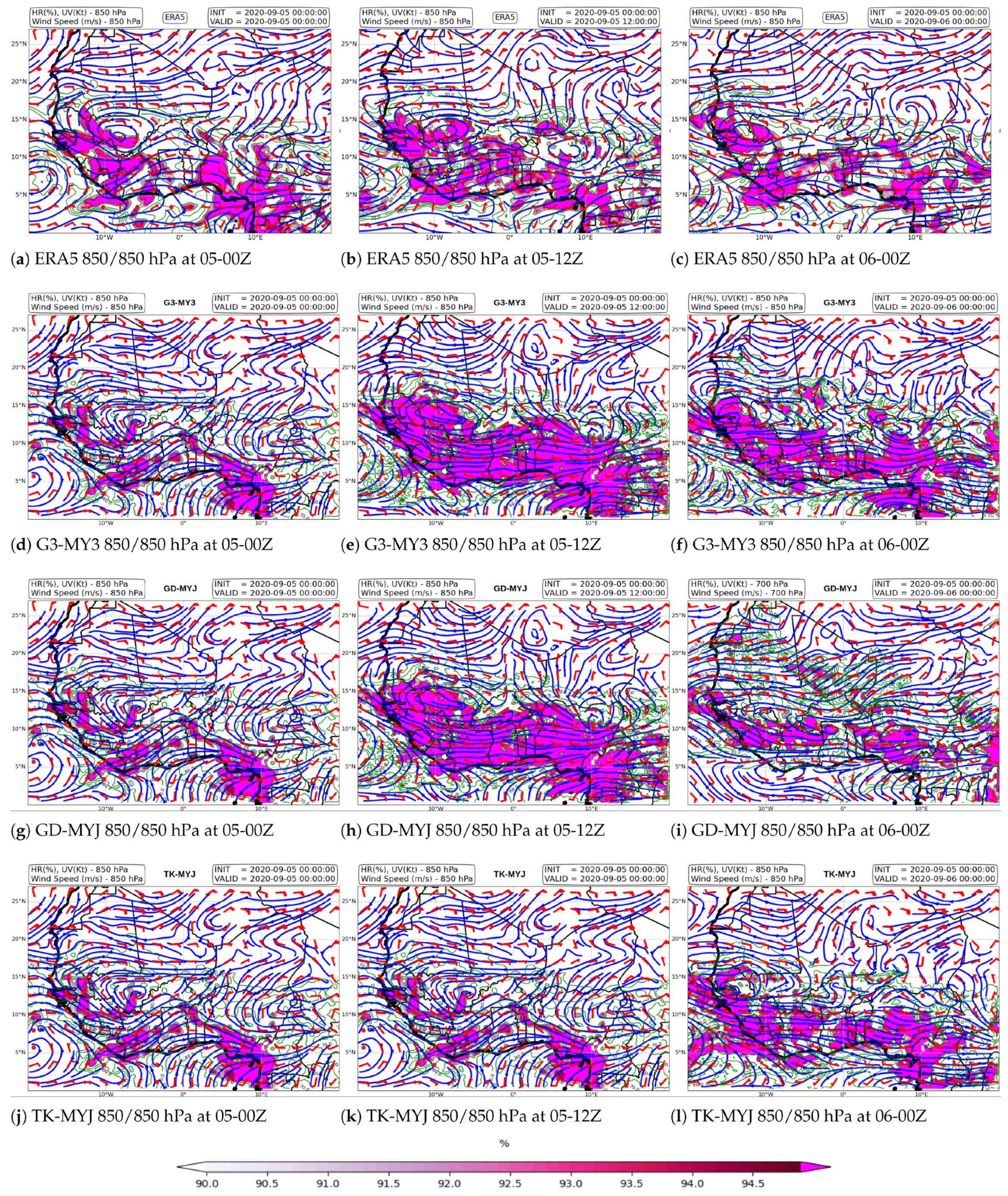

| Parameter | Dom1 | Dom2 |
|---|---|---|
| Meteo-res | 15 km | 3 km |
| Time step | 60 s | 12 s |
| Nb of points | 295 × 200 | 316 × 286 |
| Nb of levels | 51 | |
| Vertical coordinate | Hybrid | |
| Cumulus | On | Off |
| WRF Model Parameterization | Abbrev. | Source |
|---|---|---|
| Cumulus parameterization schemes (CPSs) | ||
| Grell 3D | Gr3d (5) | [47] |
| Grell–Devenyi | GD (93) | [48] |
| Kain–Fritsch | KF (1) | [49] |
| New Arakawa–Schubert | NSAS (14) | [50] |
| Tiedtke | TK (6) | [51,52] |
| Microphysics scheme (MPS) | ||
| Thompson Scheme | TS (8) | [53] |
| Radiation scheme (RAD) | ||
| RRTMG Shortwave and Longwave Schemes | RRTMG (4) | [54] |
| PBL Model | ||
| Mellor–Yamada–Janjic | MYJ (2) | [55] |
| Mellor–Yamada Nakanishi Niino | MYNN3 (6) | [56] |
| Yonsei University Scheme | YSU (1) | [57] |
| Land surface (LSM) | ||
| Unified Noah Land Surface | Noah (2) | [58] |
| WRF Configurations | CPS | PBL |
|---|---|---|
| G3-MYJ | Grell 3D | MYJ |
| G3-MY3 | Grell 3D | MYNN3 |
| G3-YSU | Grell 3D | YSU |
| GD-MYJ | GD | MYJ |
| GD-MY3 | GD | MYNN3 |
| GD-YSU | GD | YSU |
| KF-MYJ | KF | MYJ |
| KF-MY3 | KF | MYNN3 |
| KF-YSU | KF | YSU |
| TK-MYJ | TK | MYJ |
| TK-MY3 | TK | MYNN3 |
| TK-YSU | TK | YSU |
| NS-MYJ | NSAS | MYJ |
| NS-MY3 | NSAS | MYNN3 |
| NS-YSU | NSAS | YSU |
| Date | Score | ARC2 | CHIRPS | ENACTS | IMERG | ERA5 |
|---|---|---|---|---|---|---|
| 5 September 2020 | R | 0.55 | 0.39 | 0.62 | 0.41 | 0.30 |
| MAE (mm/day) | 27.0 | 32.2 | 22.7 | 29.1 | 29.1 | |
| BIAS (mm/day) | −17.3 | −28.4 | −0.1 | −14.7 | −9.8 | |
| RMSE (mm/day) | 37 | 45 | 29.7 | 38.1 | 39.6 | |
| 3 September 2021 | R | 0.32 | 0.49 | 0.84 | 0.44 | 0.54 |
| MAE (mm/day) | 11.1 | 7.4 | 3.9 | 6.6 | 8.6 | |
| BIAS (mm/day) | 5.4 | −1.6 | −0.1 | −0.1 | −8.4 | |
| RMSE (mm/day) | 13.1 | 11.2 | 6.8 | 11.7 | 14.7 |
| CPS | Grell 3D | GD | KF | TK | NSAS | ||||||||||
|---|---|---|---|---|---|---|---|---|---|---|---|---|---|---|---|
| Config | G3-MYJ | G3-MY3 | G3-YSU | GD-MYJ | GD-MY3 | GD-YSU | KF-MYJ | KF-MY3 | KF-YSU | TK-MYJ | TK-MY3 | TK-YSU | NS-MYJ | NS-MY3 | NS-YSU |
| 5 September 2020 | |||||||||||||||
| R | 0.27 | 0.13 | 0.33 | 0.38 | 0.20 | 0.14 | 0.29 | 0.20 | 0.30 | 0.40 | 0.36 | 0.41 | 0.15 | 0.37 | 0.24 |
| BIAS | −15.5 | −22.6 | −7.5 | −19.9 | −31.1 | −16.4 | −26.0 | −28.9 | −19.8 | −11.3 | −7.7 | −1.1 | −32.0 | −28.1 | −22.1 |
| MAE | 36.4 | 43.1 | 35.4 | 32.6 | 36.4 | 36.7 | 37.8 | 36.5 | 34.9 | 33.1 | 39.7 | 35.0 | 38.6 | 34.0 | 33.4 |
| RMSE | 46.3 | 55.1 | 47.8 | 43.1 | 49.0 | 48.9 | 48.0 | 49.0 | 45.6 | 44.4 | 53.4 | 45.6 | 52.8 | 46.9 | 45.7 |
| 3 September 2021 | |||||||||||||||
| R | 0.08 | −0.05 | 0.04 | 0.50 | 0.03 | 0.33 | 0.13 | 0.12 | 0.10 | 0.19 | −0.01 | 0.07 | 0.16 | −0.03 | 0.02 |
| BIAS | −6.8 | −7.9 | −6.2 | −0.9 | −7.3 | −2.8 | −7.5 | −8.6 | −7.4 | 1.6 | −7.7 | −5.2 | −5.4 | −7.7 | −6.6 |
| MAE | 9.0 | 9.2 | 9.7 | 7.5 | 9.2 | 8.3 | 9.0 | 8.6 | 9.1 | 11.6 | 9.1 | 9.8 | 8.4 | 9.2 | 9.1 |
| RMSE | 16.1 | 15.8 | 16.3 | 13.2 | 15.4 | 16.3 | 15.4 | 15.0 | 15.4 | 20.7 | 15.7 | 17.6 | 14.7 | 16.0 | 16.3 |
Disclaimer/Publisher’s Note: The statements, opinions and data contained in all publications are solely those of the individual author(s) and contributor(s) and not of MDPI and/or the editor(s). MDPI and/or the editor(s) disclaim responsibility for any injury to people or property resulting from any ideas, methods, instructions or products referred to in the content. |
© 2025 by the authors. Licensee MDPI, Basel, Switzerland. This article is an open access article distributed under the terms and conditions of the Creative Commons Attribution (CC BY) license (https://creativecommons.org/licenses/by/4.0/).
Share and Cite
Coly, A.A.; Poan, E.D.; Sane, Y.; Senghor, H.; Diouf, S.; Ndiaye, O.; Deme, A.; Gueye, D. Optimizing WRF Configurations for Improved Precipitation Forecasting in West Africa: Sensitivity to Cumulus and PBL Schemes in a Senegal Case Study. Climate 2025, 13, 181. https://doi.org/10.3390/cli13090181
Coly AA, Poan ED, Sane Y, Senghor H, Diouf S, Ndiaye O, Deme A, Gueye D. Optimizing WRF Configurations for Improved Precipitation Forecasting in West Africa: Sensitivity to Cumulus and PBL Schemes in a Senegal Case Study. Climate. 2025; 13(9):181. https://doi.org/10.3390/cli13090181
Chicago/Turabian StyleColy, Abdou Aziz, Emmanuel Dazangwende Poan, Youssouph Sane, Habib Senghor, Semou Diouf, Ousmane Ndiaye, Abdoulaye Deme, and Dame Gueye. 2025. "Optimizing WRF Configurations for Improved Precipitation Forecasting in West Africa: Sensitivity to Cumulus and PBL Schemes in a Senegal Case Study" Climate 13, no. 9: 181. https://doi.org/10.3390/cli13090181
APA StyleColy, A. A., Poan, E. D., Sane, Y., Senghor, H., Diouf, S., Ndiaye, O., Deme, A., & Gueye, D. (2025). Optimizing WRF Configurations for Improved Precipitation Forecasting in West Africa: Sensitivity to Cumulus and PBL Schemes in a Senegal Case Study. Climate, 13(9), 181. https://doi.org/10.3390/cli13090181







